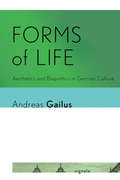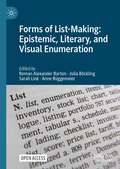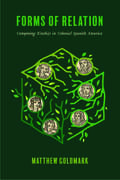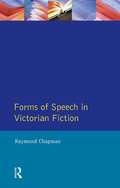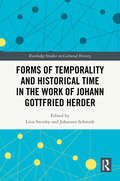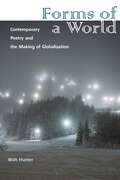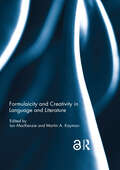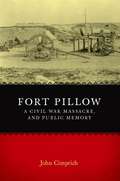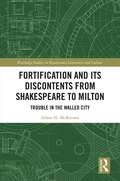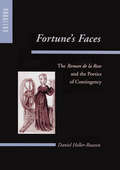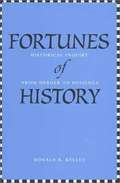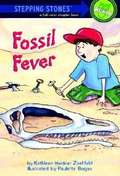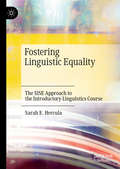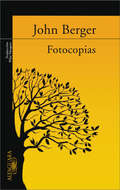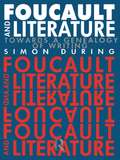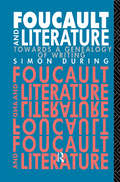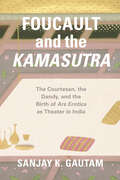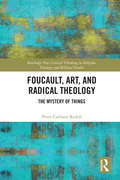- Table View
- List View
Forms of Life: Aesthetics and Biopolitics in German Culture (Signale: Modern German Letters, Cultures, and Thought)
by Andreas GailusIn Forms of Life, Andreas Gailus argues that the neglect of aesthetics in most contemporary theories of biopolitics has resulted in an overly restricted conception of life. He insists we need a more flexible notion of life: one attuned to the interplay and conflict between its many dimensions and forms. Forms of Life develops such a notion through the meticulous study of works by Kant, Goethe, Kleist, Nietzsche, Wittgenstein, Benn, Musil, and others. Gailus shows that the modern conception of "life" as a generative, organizing force internal to living beings emerged in the last decades of the eighteenth century in biological thought. At the core of this vitalist strand of thought, Gailus maintains, lies a persistent emphasis on the dynamics of formation and deformation, and thus on an intrinsically aesthetic dimension of life. Forms of Life brings this older discourse into critical conversation with contemporary discussions of biopolitics and vitalism, while also developing a rich conception of life that highlights, rather than suppresses, its protean character. Gailus demonstrates that life unfolds in the open-ended interweaving of the myriad forms and modalities of biological, ethical, political, psychical, aesthetic, and biographical systems.
Forms of List-Making: Epistemic, Literary, and Visual Enumeration
by Roman Alexander Barton Julia Böckling Sarah Link Anne RüggemeierThis open access book attempts to show that an examination of the list’s formal features has the potential to produce genuine insights into the production of knowledge, the poetics of literature and the composition of visual art. Following a conceptual introduction, the twelve single-authored chapters place the list in a variety of well-researched contexts, including ancient Roman historiography, medieval painting, Enlightenment periodicals, nineteenth-century botanical geography, American Beat poetry and contemporary photobooks. With its interdisciplinary approach, this book is a unique contribution to an emerging field dedicated to the study of lists.
Forms of Modernity
by Rachel SchmidtIt's a critical cliché that Cervantes' Don Quixote is the first modern novel, but this distinction raises two fundamental questions. First, how does one define a novel? And second, what is the relationship between this genre and understandings of modernity? In Forms of Modernity, Rachel Schmidt examines how seminal theorists and philosophers have wrestled with the status of Cervantes' masterpiece as an 'exemplary novel', in turn contributing to the emergence of key concepts within genre theory.Schmidt's discussion covers the views of well-known thinkers such as Friedrich Schlegel, José Ortega y Gasset, and Mikhail Bakhtin, but also the pivotal contributions of philosophers such as Hermann Cohen and Miguel de Unamuno. These theorists' examinations of Cervantes's fictional knight errant character point to an ever-shifting boundary between the real and the virtual. Drawing from both intellectual and literary history, Forms of Modernity richly explores the development of the categories and theories that we use today to analyze and understand novels.
Forms of Poetic Attention
by Lucy AlfordA poem is often read as a set of formal, technical, and conventional devices that generate meaning or affect. However, Lucy Alford suggests that poetic language might be better understood as an instrument for tuning and refining the attention. Identifying a crucial link between poetic form and the forming of attention, Alford offers a new terminology for how poetic attention works and how attention becomes a subject and object of poetry.Forms of Poetic Attention combines close readings of a wide variety of poems with research in the philosophy, aesthetics, and psychology of attention. Drawing on the work of a wide variety of poets such as T. S. Eliot, Wallace Stevens, Frank O’Hara, Anne Carson, Theresa Hak Kyung Cha, Harryette Mullen, Al-Khansā’, Rainer Maria Rilke, Arthur Rimbaud, and Claudia Rankine, Alford defines and locates the particular forms of attention poems both require and produce. She theorizes the process of attention-making—its objects, its coordinates, its variables—while introducing a broad set of interpretive tools into the field of literary studies. Forms of Poetic Attention makes the original claim that attention is poetry’s primary medium, and that the forms of attention demanded by a poem can train, hone, and refine our capacities for perception and judgment, on and off the page.
Forms of Relation: Composing Kinship in Colonial Spanish America (Writing the Early Americas)
by Matthew GoldmarkDrawing on literary texts, conversion manuals, and colonial correspondence from sixteenth- and seventeenth-century Spain and Peru, Forms of Relation shows the importance of textual, religious, and bureaucratic ties to struggles over colonial governance and identities.Goldmark analyzes these ties as forms of kinship forged outside of the well-studied paradigms of sex, biology, and procreation. He demonstrates how colonial actors—Spanish and Indigenous—vied for power when they argued that identity could be shaped by spiritual fatherhood, standardized education, or the regulation of doctrine. Forms of Relation illustrates why we must interrogate the dominant paradigms of mestizaje, heterosexuality, and biology that are too often left unchallenged in studies of Spanish colonialism, demonstrating how nonprocreative kinships shaped the Spanish colonial regime.
Forms of Speech in Victorian Fiction (Studies In Eighteenth and Nineteenth Century Literature Series)
by Raymond ChapmanForms of Speech in Victorian Fiction examines how Victorian writers used dialogue in the presentation of characters and the relationships between them, and its contribution to the work as a whole. Quoting over a hundred novels of the period, including all the major authors, many fascinating topics are discussed. The book also looks at the conventions which governed the writing and circulation of fiction, imposing certain restraints on the novelists. It also relates the dialogue used in Victorian fiction to evidence from other sources about the actual speech of the period. This book will be of great value to those studying the social history of the period, as well as literature, and will appeal to the general reader interested in Victorian fiction.
Forms of Temporality and Historical Time in the Work of Johann Gottfried Herder (Routledge Studies in Cultural History)
by Johannes Schmidt Liisa SteinbyThis edited collection is the first volume solely dedicated to research on Johann Gottfried Herder’s understanding of history, time, and temporalities.Although his ideas on time mark an important transition period that advanced the emergence of the modern world, scholars have rarely addressed Herder’s temporalities. In eight chapters, the volume examines and illuminates Herder’s conception of human freedom in connection with time; the importance of the concept of forces (Kräfte) for a dynamic ontology; human beings’ sensuous experience of inner and external temporality; Herder’s conception of Bildung, speculations on extra-terrestrial beings and on different perceptions of time; the mythological figure Nemesis and Herder’s view of the past and the future; the temporal dimension in Herder’s aesthetics; and Herder’s biblical studies in relationship to divine infinitude and human temporality. The volume concludes by outlining the influence of Herder’s understanding of time on following generations of thinkers.Forms of Temporality and Historical Time in the Work of Johann Gottfried Herder is ideal for scholars, graduates, and postgraduates interested in Herder’s metaphysics, epistemology, and philosophy of history, as well as any scholar concerned with eighteenth-century concepts of time and the emergence of the modern world at the beginning of the nineteenth century.
Forms of a World: Contemporary Poetry and the Making of Globalization
by Walt HunterWhat happens when we think of poetry as a global literary form, while also thinking the global in poetic terms? Forms of a World shows how the innovations of contemporary poetics have been forged through the transformations of globalization across five decades. Sensing the changes wrought by neoliberalism before they are made fully present, poets from around the world have creatively intervened in global processes by remaking poetry’s formal repertoire. In experimental reinventions of the ballad, the prospect poem, and the ode, Hunter excavates a new, globalized interpretation of the ethical and political relevance of forms. Forms of a World contends that poetry’s role is not only to make visible thematically the violence of global dispossessions, but to renew performatively the missing conditions for intervening within these processes. Poetic acts—the rhetoric of possessing, belonging, exhorting, and prospecting—address contemporary conditions that render social life ever more precarious. Examining an eclectic group of Anglophone poets, from Seamus Heaney and Claudia Rankine to Natasha Trethewey and Kofi Awoonor, Hunter elaborates the range of ways that contemporary poets exhort us to imagine forms of social life and enable political intervention unique to but beyond the horizon of the contemporary global situation.
Formulaic Language and Linguistic Change: A Data-Led Approach
by Andreas BuerkiA substantial proportion of our everyday language is 'formulaic', that is, it consists of oft-repeated chunks. From pause fillers such as you know, to phrases such as Many thanks!, Is this seat taken? or strong tea, they form a phenomenon central in language. This important new book investigates formulaic language from the point of view of language change. Employing a novel quantitative and data-led approach, it traces and analyses change in phraseology across 20th Century German as used in Switzerland. Drawing on nearly 20 million words of textual evidence, it shows that social and cultural change in the speech community is the predominant motivator of change, though other factors are also at play. The book demonstrates a close link between language change and the culture of the speech community, arguing that this has repercussions for the study of language in general, as well as the study of society and history.
Formulaicity and Creativity in Language and Literature
by Ian MacKenzie Martin A. KaymanThe chapters in this book elucidate the nature of semi-fixed formulaic sequences; how the meaning of formulaic expressions can change over time; how readers interpret formulaic expressions in first and second languages; how modern and postmodern authors use traditional genres and tales to challenging effect; and how formulaic patterns involving particular words can underlie the texture and meanings of entire novels. Together, the contributions to this collection provide a convincing reassessment of the potential creativity of the formulaic in a variety of linguistic and literary contexts. This book was originally published as a special issue of the European Journal of English Studies. Chapter 1 of this book is freely available as a downloadable Open Access PDF at http://www.taylorfrancis.com under a Creative Commons Attribution-Non Commercial-No Derivatives (CC-BY-NC-ND) 4.0 license.
Fort Pillow, a Civil War Massacre, and Public Memory: Civil War Battlefields and Historic Sites Recaptured (Conflicting Worlds: New Dimensions of the American Civil War)
by John CimprichAt the now-peaceful spot of Tennessee's Fort Pillow State Historic Area, a horrific incident in the nation's bloodiest war occurred on April 12, 1864. Just as a high bluff in the park offers visitors a panoramic view of the Mississippi River, John Cimprich's absorbing book affords readers a new vantage on the American Civil War as viewed through the lens of the Confederate massacre of unionist and black Federal soldiers at Fort Pillow.Cimprich covers the entire history of Fort Pillow, including its construction by Confederates, its capture and occupation by federals, the massacre, and ongoing debates surrounding that affair. He sets the scene for the carnage by describing the social conflicts in federally occupied areas between secessionists and unionists as well as between blacks and whites. In a careful reconstruction of the assault itself, Cimprich balances vivid firsthand reports with a judicious narrative and analysis of events. He shows how Major General Nathan B. Forrest attacked the garrison with a force outnumbering the Federals roughly 1,500 to 600, and a breakdown of Confederate discipline resulted. The 65 percent death toll for black unionists was approximately twice that for white unionists, and Cimprich concludes that racism was at the heart of the Fort Pillow massacre.Fort Pillow, a Civil War Massacre, and Public Memory serves as a case study for several major themes of the Civil War: the great impact of military experience on campaigns, the hardships of military life, and the trend toward a more ruthless conduct of war. The first book to treat the fort's history in full, it provides a valuable perspective on the massacre and, through it, on the war and the world in which it occurred.
Fortification and Its Discontents from Shakespeare to Milton: Trouble in the Walled City (Routledge Studies in Renaissance Literature and Culture)
by Adam N. McKeownFortification and Its Discontents from Shakespeare to Milton gives new coherence to the literature of the early modern Atlantic world by placing it in the context of radical changes to urban space following the Italian War of 1494-1498. The new walled city that emerged in the sixteenth and seventeenth centuries on both sides of the Atlantic provided an outlet for a wide range of humanistic fascinations with urban design, composition, and community organization, but it also promoted centrality of control and subordinated the human environment to military functionality. Examining William Shakespeare, Edmund Spenser, John Winthrop, and John Milton, this volume shows how the literature of England and New England explores and challenges the new walled city as England struggled to define the sprawling metropolis of London, translate English urban spaces into Ireland and North America, and, later, survive a long civil war.
Fortune's Faces: The Roman de la Rose and the Poetics of Contingency (Parallax: Re-visions of Culture and Society)
by Daniel Heller-RoazenArguably the single most influential literary work of the European Middle Ages, the Roman de la Rose of Guillaume de Lorris and Jean de Meun has traditionally posed a number of difficulties to modern critics, who have viewed its many interruptions and philosophical discussions as signs of a lack of formal organization and a characteristically medieval predilection for encyclopedic summation. In Fortune's Faces, Daniel Heller-Roazen calls into question these assessments, offering a new and compelling interpretation of the romance as a carefully constructed and far-reaching exploration of the place of fortune, chance, and contingency in literary writing.Situating the Romance of the Rose at the intersection of medieval literature and philosophy, Heller-Roazen shows how the thirteenth-century work invokes and radicalizes two classical and medieval traditions of reflection on language and contingency: that of the Provençal, French, and Italian love poets, who sought to compose their "verses of pure nothing"in a language Dante defined as "without grammar," and that of Aristotle's discussion of "future contingents" as it was received and refined in the logic, physics, theology, and epistemology of Boethius, Abelard, Albert the Great, and Thomas Aquinas.Through a close analysis of the poetic text and a detailed reconstruction of the logical and metaphysical concept of contingency, Fortune's Faces charts the transformations that literary structures (such as subjectivity, autobiography, prosopopoeia, allegory, and self-reference) undergo in a work that defines itself as radically contingent. Considered in its full poetic and philosophical dimensions, the Romance of the Rose thus acquires an altogether new significance in the history of literature: it appears as a work that incessantly explores its own capacity to be other than it is.
Fortunes of History: Historical Inquiry from Herder to Huizinga
by Donald R. KelleyDonald R. Kelley offers an authoritative examination of historical writing during the "long nineteenth century" - the years from the French Revolution to those just after the First World War. He provides a comprehensive analysis of the theories and practices of British, French, German, Italian, and American schools of historical thought, their principal figures, and their distinctive methods and self-understandings. Kelley treats the modern traditions of European world and national historiography from the Enlightenment to the "new histories" of the twentieth century, attending not only to major authors and schools but also to methods, scholarship, criticisms, controversies, ideological questions, and relations to other disciplines. --BOOK JACKET. Title Summary field provided by Blackwell North America, Inc. All Rights Reserved
Fossil Fever
by Kathleen Weidner ZoehfeldJeff’s Uncle Roy runs a museum. That means he’s always zooming off to strange places to find ruins and treasure. But Jeff has never gone along—until now. They’re headed to the Sahara desert to search for dinosaur fossils. And Jeff knows he’ll find the bones of the biggest meat-eater ever! “The subject’s popularity, and Bogan’s colorful cartoon-style illustrations will attract beginning readers. ”—Booklist From the Trade Paperback edition.
Fostering Linguistic Equality: The SISE Approach to the Introductory Linguistics Course
by Sarah E. HerculaThis book offers one possible solution in the pursuit of linguistic equality by exploring how the Structural Inquiry of Stigmatized English (SISE) approach to linguistics pedagogy can be used to empower linguistics students and researchers as ambassadors for change. By using stigmatized varieties of English (including African American English, Chicano English, and Appalachian English) as the primary linguistic data analyzed through detailed structural analysis, the SISE approach fosters linguistically principled and pluralistic language attitudes among students, as evidenced by the author’s own empirical research in applying the method. This book not only advocates for linguistic equality but also provides teachers and researchers with the tools they need to counteract prejudicial attitudes and disinformation about language both in and outside the classroom. It will be an essential resource for linguistics teachers, applied linguists, curriculum developers, students and scholars of language attitudes and language variation, and anyone seeking more information about the relationships between diversity, (in)equality, and language.
Fotocopias
by John Berger¿Alguna vez has mirado una fotografía y te has preguntado por las vidas de las personas que han sido captadas por el objetivo de la cámara? El original es la realidad; estas Fotocopias nos regalan una visión literaria y panorámica de ella. John Berger presenta una colección de encuentros vividos por el autor en la Europa de finales de milenio. Veintinueve momentos que, en conjunto, conforman un fresco de la historia de la humanidad, así como un autorretrato de su autor. Por sus páginas nos cruzamos con amigos, con viajeros en estaciones de tren, con campesinos, con Simone Weil en su apartamento de París, con vecinos, con extraños en cafés, con el fotógrafo Henri Cartier-Bresson, con pintores y otros artistas. Personas -más que personajes- observadas con una mirada lúcida, sencilla, bondadosa e intensa que recorre todas las dimensiones y posibilidades de lo cotidiano. Puro John Berger: su frescura, su fe en la liberación, la esperanza y la vida. Reseñas:«En la literatura contemporánea, John Berger me parece incomparable.»Susan Sontag «John Berger guía a sus lectores con ternura y con un humor íntimo.»Michael Ondaatje «¿Alguna vez has mirado una fotografía y te has preguntado por las vidas de las personas que han sido captadas por el objetivo de la cámara? Berger ofrece al lector este tipo de destello en su nueva colección de relatos. (...) Los personajes de cada una de las viñetas parecen tener unas vidas ricas y plenas fuera y más allá de los confines de sus historias, y Berger nos ha dado sólo una pequeña muestra de ellas.»Library Journal «Bellamente construida... Escrita con elegante sencillez e integridad... El Berger más apasionante.»The Sunday Times «Uno de los escritores contemporáneos más ingeniosos e imaginativos.»The New York Times Book Review
Foucault and Literature
by Simon DuringFirst published in 2012. Routledge is an imprint of Taylor & Francis, an informa company.
Foucault and Literature: Towards a Genealogy of Writing
by Simon DuringThe writings of the French historian, literary critic and philosopher Michel Foucault have been of immense importance to developments in literary studies since the late 1970s. He, more than anyone, stands behind the new historicism' and cultural materialism' that currently dominate international literary studies. Simon During provides a detailed introduction to the whole body of Foucault's work, with a particular emphasis on his literary theory. His study takes in Foucault's early studies of transgressive' writing from Sade and Artaud to the French new novellists' of the 1960s, and his later concern with the genealogy of the author/intellectual, writing and theorizing within specific, historical mechanisms of social control and production. Foucault and Literature offers a critique both of Foucault and of the literary studies that have been influenced by him, and goes on to develop new methods of post-Foucauldian literary/cultural analysis.
Foucault and the Kamasutra: The Courtesan, the Dandy, and the Birth of Ars Erotica as Theater in India
by Sanjay K. GautamThe Kamasutra is best known in the West for its scandalous celebration of unbridled sensuality. Yet, there is much, much more to it; embedded in the text is a vision of the city founded on art and aesthetic pleasure. In Foucault and the "Kamasutra", Sanjay K. Gautam lays out the nature and origin of this iconic Indian text and engages in the first serious reading of its relationship with Foucault. Gautam shows how closely intertwined the history of erotics in Indian culture is with the history of theater-aesthetics grounded in the discourse of love, and Foucault provides the framework for opening up an intellectual horizon of Indian thought. To do this, Gautam looks to the history of three inglorious characters in classical India: the courtesan and her two closest male companions--her patron, the dandy consort; and her teacher and advisor, the dandy guru. Foucault's distinction between erotic arts and the science of sexuality drives Gautam's exploration of the courtesan as a symbol of both sexual-erotic and aesthetic pleasure. In the end, by entwining together Foucault's works on the history of sexuality in the West and the classical Indian texts on eros, Gautam transforms our understanding of both, even as he opens up new ways of investigating erotics, aesthetics, gender relations, and subjectivity.
Foucault, Art, and Radical Theology: The Mystery of Things (Routledge New Critical Thinking in Religion, Theology and Biblical Studies)
by Petra Carlsson RedellMichel Foucault wrote prolifically on many topics including, art, religion, and politics. He also eloquently articulated how power structures are formed and how they also might assist resistance and emancipation. This book uses the hermeneutical lens of Foucault’s writings on art to examine the performative, material, and political aspects of contemporary theology. The borderland between philosophy, theology, and art is explored through Foucault’s analyses of artists such as Diego Velázquez, Édouard Manet, René Magritte, Paul Rebeyrolle, and Gerard Fromanger. Here special focus is placed on performativity and materiality—or what the book terms the mystery of things. At successive junctures, the book discovers a postrepresentational critique of transcendence; an enigmatic material sacramentality; playful theopolitical accounts of the transformative force of stupidity and nonsense; and political imagery in motion enabling theological interpretations of contemporary collectives such as Pussy Riot and the Sisters of Perpetual Indulgence. In conversation with contemporary thinkers including Catherine Keller, Louise-Marie Chauvet, John Caputo, Daniel Barber, Mark C. Taylor, Jeffrey W. Robbins, and Mattias Martinson, the book outlines this source of inspiration for contemporary radical theology. This is a book with a fresh and original take on Foucault, art, and theology. As such, it will have great appeal to scholars and academics in theology, religion and the arts, the philosophy of religion, political philosophy, and aesthetics.
Found Alphabet
by Ramon ShindlerThe ordinary becomes the extraordinary within the pages of Found Alphabet, a fantastic collaboration of Polish artists. The four creators of Found Alphabet reside in Kraków, Poland. This is their first book published in the United States.
Found in Translation
by J. Michael WaltonIn considering the practice and theory of translating plays into English from Classical Greek from a theatrical perspective, Found in Translation also addresses wider issues of transferring any piece of theatre from a source into a target language. The history of translating classical tragedy and comedy, here fully investigated for the first time, demonstrates how through the ages translators have, wittingly or unwittingly, appropriated Greek plays and made them reflect socio-political concerns of their own era. Chapters are devoted to topics including verse and prose, mask and non-verbal language, stage directions and subtext and translating the comic. Among the plays discussed as 'case studies' are Aeschylus' Agamemnon, Sophocles' Oedipus Tyrannus and Euripides' Medea and Alcestis. The book concludes with a consideration of the boundaries between 'translation' and 'adaptation', followed by an Appendix of every translation of Greek tragedy and comedy into English from the 1550s to the present day.
